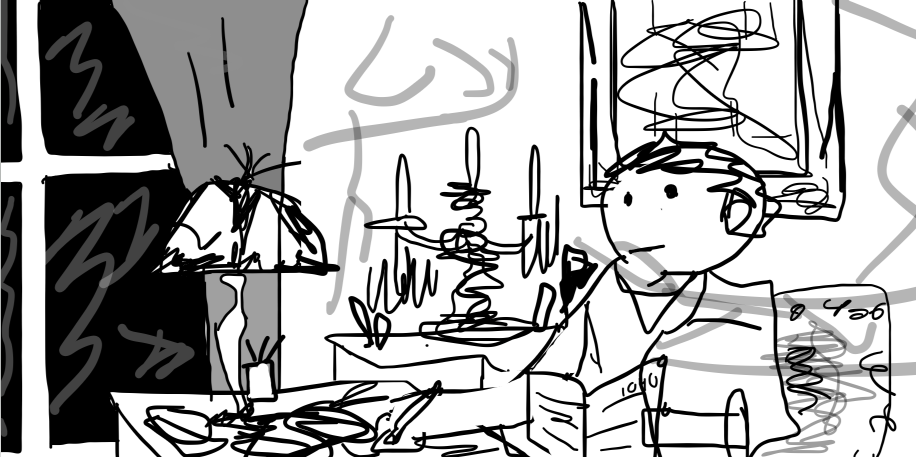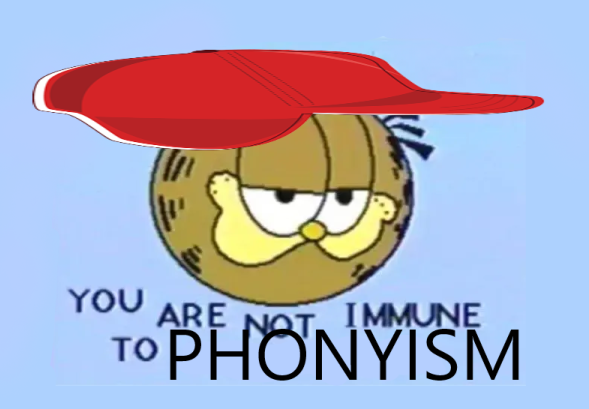A Grandiose Embellishment-filled Blog Post on Fun Home to Obfuscate My Darkest Secrets...
This shady practice which I am engaging in sounds familiar. So familiar, that I can name at least one character from a book which I have read who has also engaged in this practice: Bruce Bechdel. Now, calling Bruce's entire housing restoration and his love of embellished decorations a "cover-up" sounds like quite a stretch. And to my knowledge, there's no concrete evidence that this was the intent when Bruce went on his journey of restoring his home to its former glory. But nevertheless, we can see how Bruce's efforts at restoration in effect create a veil, a second identity, which he can use to hide the parts of himself which he does not want to world to see.
A HUGE FANCY HOUSE and the guy who created it
Alas, for all the decoration one can do to obscure misdeeds to the wider world...
(image neatly and faithfully copied from page 60)
Lies! Slander! Libel! Falsehoods! Trickery!
Alison repeatedly disparages her dad's aesthetic preferences throughout the book. This critique goes far beyond what an average disagreement over aesthetics might usually entail, with Alison using particularly harsh words when describing what she hated about her father's decorations. As Alison herself put it, she "developed a contempt for useless ornament," and questioned the "scrolls, tassels, and bric-a-brac" that "infested" her house (Bechdel 16). She found that much of Bruce's stuff had seemingly no real purpose or function. That sentiment is believable, and for the most part, true, since all of Bruce's ornaments are really only to be aesthetically pleasing.
Although if they exist for visual pleasure, doesn't that count as a purpose already? Maybe not in the way Alison means, in which these extra features improve functionality by say, making a mirror better at reflecting. Rather, they serve a purpose in the more abstract sense.
In the next few panels, Alison makes another assertion about her father's decorations. Perhaps contradictorily, they were not only useless, but they "obscured function. They were embellishments in the worst sense...they were lies" (Bechdel 16). So, if these embellishments were lies, what sort of lies are they? We all (hopefully) know of Bruce's secret affairs, and how he hides them away for as few people as possible to see. But how do these inanimate things play a role in building Bruce's lies, and what narrative do they push in its place?
All-Metal Submarines Cannot Incubate Phonies
Compare Bruce's aesthetic style to Alison's, and we find white and black difference. Alison described herself as "Spartan to my father's Athenian. Modern to his Victorian. Butch to his nelly. Utilitarian to his aesthete" (15). This core difference between the two manifests itself throughout the novel, and many things about one character (stylistic or otherwise) has an opposite counterpart in the other.
Firstly, home decoration. Alison, as a kid, sulking about Bruce's 'useless' ornaments, says that as an adult, her home "is going to be all-metal, like a submarine" (14). A blank room. Nothing to appreciate aesthetically - nothing to distract - nothing to blend into. And later on in the book, she, to some extent, makes good on her promise. While not exactly the cramped living environment of a submarine, Alison does have a college dorm. If you want pictures, see the frames on page 58, 59, and 79. Where Bruce has embellished, floral, and intricate decorations in a large grandiose home, Alison has bare tiled floors, cramped brick walls, and cheap, blocky furniture within a cramped apartment, with each item serving a distinct purpose. Like I said, white and black difference.
Outside of interior design, Bruce and Alison are opposites in another fundamental way. Alison is openly lesbian, while Bruce is closeted. Where Alison embraces her identity, and is more than comfortable with people in her social circle knowing, Bruce keeps his homosexuality as a dark secret, and hides behind the doors of his closet.
...a closet which happens to have a very intriguing Victorian design.
Meanwhile, Alison's closet is made of hastily riveted metal, and coincidentally wide open. I suppose her door didn't have enough antique appeal.
Alison's aesthetic preferences for simplicity and functionality correlate strongly with her openness about her identity, and vice versa for Bruce. Alison's stuff is unembellished - she is open. Bruce's stuff is embellished - he is closed.
Table. worst thing i ever drew. on with the stupid blog post already.
Okay, so there's a correlation between Bruce's embellishments and his closeted homosexuality. But correlation isn't causation. Is there a plausible way in which Bruce's home decoration works as a symbol of his hiding?
Yes.
Simply put, the home which Bruce constructs acts as a 'hiding' place, where Bruce can blend into the scenery of the house and distract others with its grandiosity. The end result is that the conversation around Bruce tends to revolve around his house. Since the house is Bruce's most tangible accomplishment, it's the easiest thing to recognize and talk about. Even the book itself begins with Bruce's relationship with his house.
If you look at many of the illustrations of Bruce in his house, oftentimes, the background can overwhelm the foreground. The prime example here would be the graphics on page 60 and 61. The decorated room takes up the vast majority of the pages, leaving only a bit of page-space to the characters and the interaction between Bruce and Roy.
Compare that to the pages before, where each frame is occupied with Alison front and center.
A Normal Section About a Not Very Remarkable Bruce Bechdel
Essentially, these decorations create a narrative about Bruce centered around his Victorian house, and the connotations of living in an ornate house, picturesque family. Bruce's house conveys his 'success' at not only establishing a stereotypical American nuclear family, but also in living up to the standards of a family of the 19th century, surrounding himself with symbols of that idyllic antique life. By appealing to this historical tradition, he effectively fits in to the conservative, conformist culture of the 1950s.
Think of how the library on page 60 sells us this idea. It tells us something like: "Bruce is a scholar, a little aristocrat who built up a beautiful abode." Or the frames on page 16-17, which are integral in building the readers' first impression of the book. The frame shows us that this is a calm, albeit somewhat drab and depressing, family, stuck in the past, and held together by Bruce, the literal architect of the family and "ideal husband and father," as Alison calls it (17). When she returns to accusing her family of being a sham, Alison intentionally picks the word "museum" to describe it. Frozen in time, and merely a snapshot of a romanticized ideal of the 19th-20th century family, a pristinely constructed display where nothing of note happens.






Very interesting formatting. Made me do a double take. Good points were made. I think Alison dogs on Bruce a little too much for liking aesthetics.
ReplyDelete